The Cebu Flowerpecker is a critically endangered bird, with only 60-70 individuals remaining in fragmented forest patches on Cebu. This species has faced severe habitat loss and degradation due to deforestation and conversion of land for agriculture. The Cebu Flowerpecker is also threatened by trapping for the illegal bird trade. As such, immediate and effective conservation efforts for philippine cockatoo are crucial to protect the remaining individuals and their habitat from further destruction. These efforts may include habitat restoration, anti-poaching measures, and community education and involvement.
These patches are primarily found in Tabunan, Nug-as, and Dalaguete, where habitat loss has reduced forest cover to a mere 0.03% of its original size.
The species relies heavily on small fruits and mistletoe-like plants for food, which are scarce due to human activities like deforestation and illegal logging.
For example, the destruction of forests has led to a significant decrease in the availability of its primary food sources.
Protecting the Cebu Flowerpecker is vital, not only for its survival but also for maintaining ecological balance.
Understanding its challenges illuminates the urgent need for effective conservation measures and community involvement, which can help address the habitat loss and food scarcity issues facing the species.
Overview of Cebu Flowerpecker
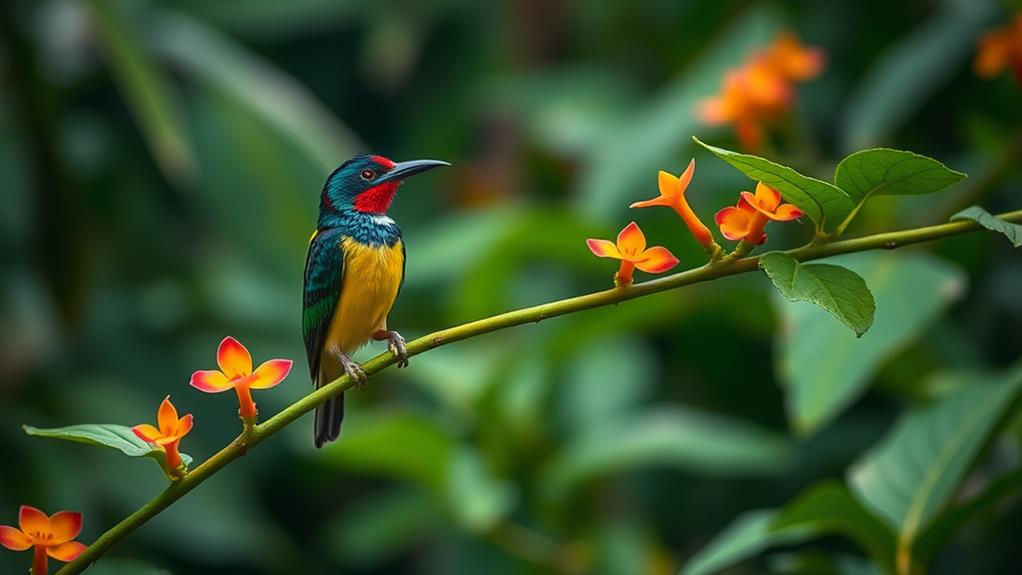
The Cebu Flowerpecker: A Critically Endangered Species
The Cebu Flowerpecker (Dicaeum quadricolor) is a critically endangered bird species found only in Cebu, with an estimated population of just 60-70 individuals.
Habitat and Distribution
The Cebu Flowerpecker inhabits fragmented forest patches in Cebu, particularly in Tabunan, Nug-as, and Dalaguete.
These forest patches are crucial for the species' survival.
Physical Characteristics
The Cebu Flowerpecker exhibits sexual dimorphism.
Males have vibrant red backs and glossy blue-black plumage, while females have more subdued brown and olive tones.
Diet
The Cebu Flowerpecker primarily feeds on small fruits and mistletoe-like plants, with the Cebu Mistletoe (Lepeostegeres cebuensis) being a crucial part of its diet.
Threats
Habitat loss due to deforestation and illegal activities poses a significant threat to the Cebu Flowerpecker's existence.
Conservation Efforts
Conservation efforts are vital to counteract these challenges.
Habitat rehabilitation, protective measures, and community engagement initiatives aim to preserve the Cebu Flowerpecker's environment and mitigate the impact of human activities.
Conservation Status
The Cebu Flowerpecker is critically endangered, with a dwindling population of 85-105 individuals, and only 60-70 mature birds remaining as of 2005. This alarming conservation status reflects the urgent need for targeted action.
Habitat fragmentation, mainly due to deforestation, has decimated its environment, leaving Cebu Island with only 0.03% of its original forest cover.
Major threats to the Cebu Flowerpecker's survival include illegal settlements, road construction, and illicit logging. These activities critically undermine conservation efforts, emphasizing the need for updated strategies. The IUCN Red List categorizes the Cebu Flowerpecker as a threatened species, indicating an immediate requirement for action.
To enhance the survival of this species, concerted conservation efforts are essential. These efforts must include the strict protection of remaining forest tracts and habitat rehabilitation initiatives.
For example, designating areas like Mt. Lantoy as a national park could help preserve the species' habitat. Without decisive action, the Cebu Flowerpecker's future will remain precarious.
Habitat and Distribution
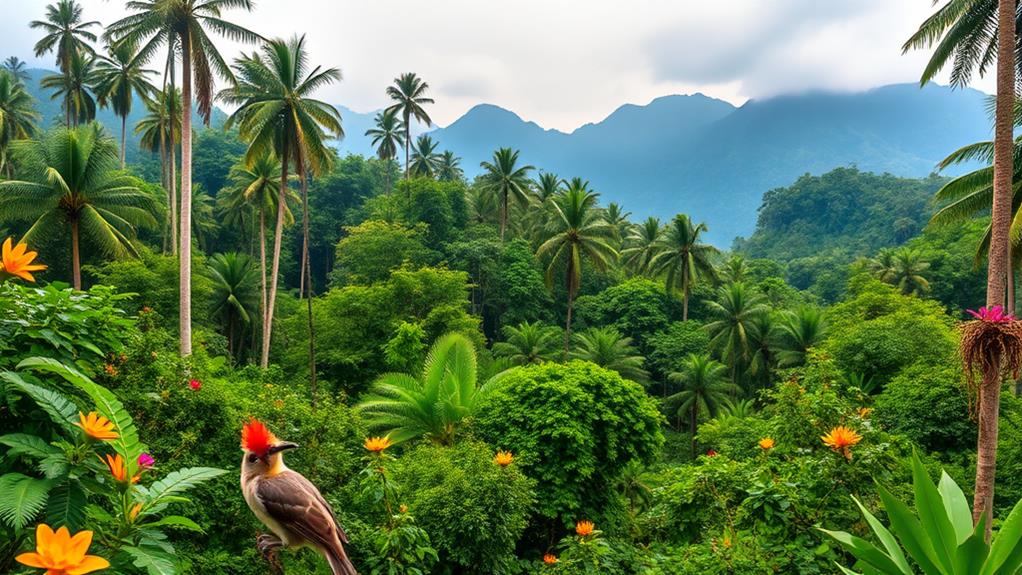
Cebu's Unique Ecological Landscape
The island of Cebu is home to the critically endangered Cebu Flowerpecker (Dicaeum quadricolor), which inhabits the remaining forest patches.
Only about 0.03% of the original forest cover remains on Cebu due to extensive deforestation.
Habitat Preferences
The Cebu Flowerpecker prefers closed-canopy forests and areas rich in flowering or fruiting plants.
It often inhabits secondary and selectively logged forests adjacent to native vegetation.
Distribution and Population
The species has a fragmented distribution, with recent population estimates revealing approximately 50-60 individuals at Nug-As, 25-30 at Tabunan, and a mere 10-15 at Dalaguete.
Its total estimated range is a mere 8 km², highlighting the critical limitations on its habitat.
Conservation Importance
Protecting the remaining forest patches is vital for the Cebu Flowerpecker's survival and a crucial step toward preserving the delicate balance of Cebu's unique ecosystem.
Ecology and Behavior
Habitat and Diet
The Cebu Flowerpecker inhabits open and closed-canopy forests, often found in secondary or selectively logged areas adjacent to native vegetation. Its unique habitat influences its diet, which largely consists of mistletoe-like plants, ripe Ficus fruits, and flowering native trees. The endemic Cebu Mistletoe (Lepeostegeres cebuensis) is particularly vital to its survival.
Breeding and Sexual Dimorphism
The Cebu Flowerpecker's breeding season is suspected to occur between February and August, highlighting its reliance on the limited resources available within its shrinking habitat. Sexual dimorphism is present, with males showcasing vibrant red backs and glossy blue-black plumage, while females exhibit more subdued brown and olive hues.
Foraging Behavior
The Cebu Flowerpecker's foraging behavior is swift, as it quickly feeds on fruits and flowers, often departing immediately. This behavior enhances its role as a crucial seed disperser in its environment.
Key Points
| Aspect | Details |
|---|---|
| Habitat | Open and closed-canopy forests |
| Breeding | February to August |
| Sexual Dimorphism | Males: vibrant red; Females: subdued colors |
Diet and Feeding Habits

Diet and Feeding Habits
The Cebu Flowerpecker's diet consists primarily of small fruits from mistletoe-like plants and ripe Ficus fruits, which are essential for its energy needs and reproductive success.
Preferred Food Sources: The endemic Cebu Mistletoe (Lepeostegeres cebuensis) is a primary diet component, providing essential nutrients year-round. This is because the Cebu Mistletoe is a consistent food source, available throughout the year.
Feeding Behavior: The Cebu Flowerpecker exhibits quick pecking at fruits, allowing for efficient foraging. This behavior enables the bird to minimize its exposure to predators, as it swiftly departs after feeding.
Habitat Flexibility: The Cebu Flowerpecker can thrive in both open and closed-canopy forests, including secondary and selectively logged areas, as long as flowering or fruiting plants are nearby. This adaptability allows the bird to survive in a variety of habitats.
Seed Dispersal Role: The Cebu Flowerpecker's diet contributes significantly to seed dispersal, fostering the regeneration of the native forest ecosystem. This is a critical function in maintaining biodiversity, as it helps to spread seeds to new areas, promoting the growth of new plants.
Threats to Survival
The Cebu Flowerpecker's population has dwindled to a mere 60-70 individuals, making it critically endangered. This drastic decline is primarily caused by habitat loss and fragmentation resulting from rampant deforestation.
In the Cebu region, only 0.03% of the original forest cover remains, leaving the Cebu Flowerpecker to rely heavily on the remaining forest patches.
These critical habitats are under constant threat from human activities, such as agriculture, illegal settlement, and road construction. As a result, the Cebu Flowerpecker faces increased competition with the Red-keeled Flowerpecker for limited resources, including food and nesting sites.
Typhoon Haiyan worsened the plight of this species, causing substantial leaf and fruit loss in affected areas.
Immediate intervention is necessary to address habitat destruction and resource scarcity to prevent the extinction of the Cebu Flowerpecker.
Population Trends

The Cebu Flowerpecker population is critically endangered, with estimates ranging from 60 to 70 mature individuals.
Historically, the species was thought to be extinct in the early 20th century, but its rediscovery in 1992 highlighted its precarious status. Recent surveys reveal a fragmented population:
50-60 individuals are found in the Nug-As area, 25-30 individuals in Tabunan, and 10-15 individuals in Dalaguete.
The overall population continues to decline due to habitat loss and competition from other species. To combat this, conservation efforts focus on maintaining and protecting the breeding population, aiming to increase numbers within the next 5-10 years.
However, without immediate action to address habitat loss and enhance connectivity between fragmented sites, the Cebu Flowerpecker's future remains uncertain.
Creating sustainable environments that support this rare species is crucial. By prioritizing conservation, we can hope to reverse the declining trend and secure a future for the Cebu Flowerpecker.
Conservation Actions
Conservation efforts are crucial for the survival of the Cebu Flowerpecker. Between 1999 and 2004, the Cebu Biodiversity Conservation Foundation led habitat rehabilitation and protection activities to preserve the bird's limited habitat.
For instance, reforestation initiatives near Tabunan Forest have been essential in enhancing ecological connectivity by establishing corridors that link fragmented habitats.
Regular patrols are necessary to deter illegal logging. Local wardens, supported by the municipal government, conduct regular patrols to prevent illegal logging, a significant threat to the remaining forest tracts where the Cebu Flowerpecker resides.
Stricter protection of critical habitats is vital. Proposals for designating Mt Lantoy as a national park are essential for bolstering conservation efforts, providing a protected area where the species can thrive.
Community-based forest management agreements are effective in habitat preservation. These agreements empower local organizations to manage and protect the Nug-As Forest, a crucial habitat for the Cebu Flowerpecker's survival.
Collaboration among stakeholders is essential for effective habitat preservation. The concerted conservation efforts highlight the importance of collaboration among various stakeholders to safeguard this endangered species.
Community Involvement
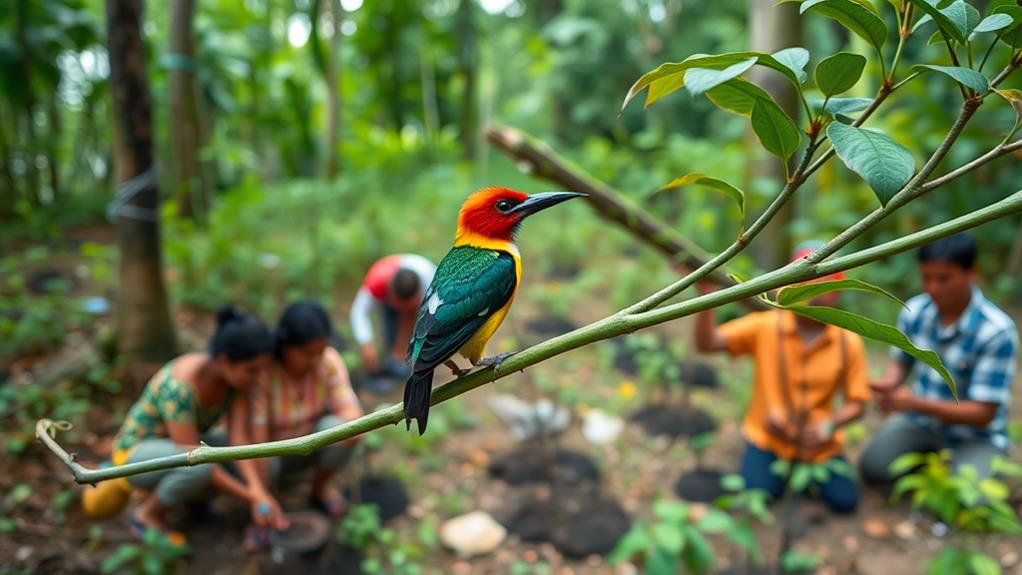
Community Involvement is Crucial for Conservation
Community involvement is essential for the conservation of the Cebu Flowerpecker and its habitat.
Local communities play a vital role in implementing effective conservation strategies, ensuring the survival of this critically endangered bird. By fostering stewardship, they actively participate in habitat rehabilitation and protection activities.
Education is Key to Awareness
Education programs raise awareness among locals about the importance of conserving the Cebu Flowerpecker.
These initiatives help locals understand the significance of protecting the bird and the detrimental effects of illegal resource use.
Forest Management Promotes Sustainability
Community organizations manage forest areas under community-based agreements, promoting sustainable practices while protecting native habitats.
This approach ensures the conservation of the Cebu Flowerpecker's habitat.
Ecological Corridors Connect Fragmented Habitats
Creating ecological corridors is vital for connecting fragmented habitats, enabling the Cebu Flowerpecker to thrive.
This involves local communities working together to establish corridors that allow the bird to roam freely.
Monitoring Patrols Enhance Protection Efforts
Regular forest patrols conducted by local wardens, supported by the municipal government, enhance monitoring and protection efforts.
These patrols help to prevent illegal activities and ensure the habitat remains protected.
Research and Monitoring
Accurate population estimates are crucial for conservation efforts. Research and monitoring are essential to understand the status of the Cebu Flowerpecker. Population surveys in key habitats like Nug-As, Tabunan, and Dalaguete reveal an alarming estimate of only 60-70 individuals remaining.
Habitat fragmentation and competition threaten the Cebu Flowerpecker's survival. Research has shown that these factors necessitate focused monitoring programs to assess their impacts.
Collaborative initiatives among local ornithologists and conservation groups enhance our understanding of the Cebu Flowerpecker's ecology and behavior, which is essential for effective habitat management.
Ongoing updates to species factsheets inform necessary conservation strategies. Organizations like BirdLife International play a pivotal role in documenting any changes to the Cebu Flowerpecker's status.
Community wardens conduct regular forest patrols and monitoring activities. These efforts guard against illegal logging and encroachment, which further jeopardize the remaining populations and their habitats.
Each action taken to protect the Cebu Flowerpecker contributes to preserving biodiversity and ensuring the survival of this critically endangered bird.
Future Goals
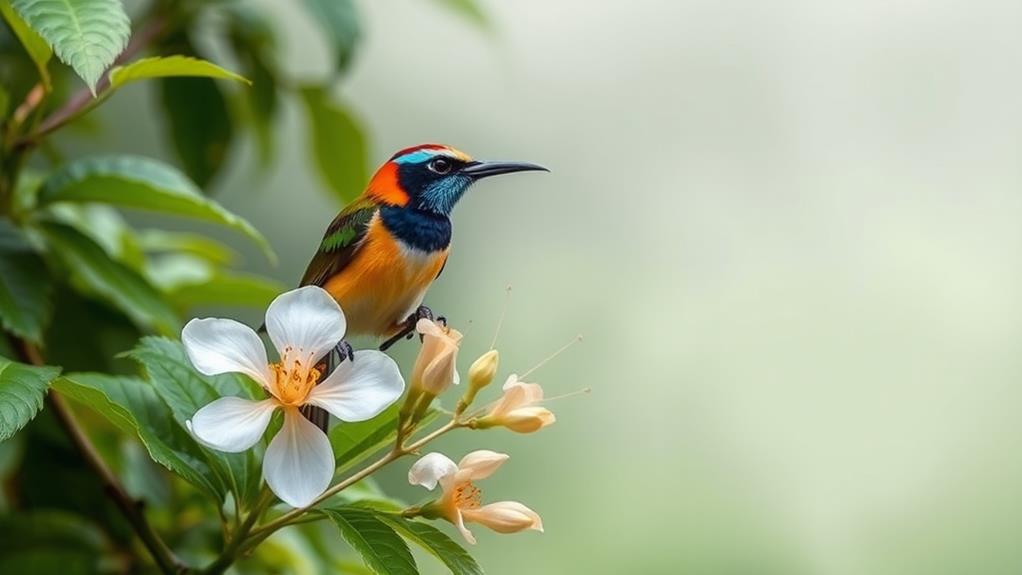
Future Goals for Cebu Flowerpecker Conservation
To ensure the survival of the critically endangered Cebu Flowerpecker, stakeholders are setting ambitious goals to restore its population within expanding natural forests over the next 30-50 years.
Establishing Protected Areas
Conservation efforts will focus on creating and maintaining protected habitats to ensure a stable breeding population of the Cebu Flowerpecker.
Within the next 5-10 years, these protected areas will provide a safe haven for the species to thrive.
Enhancing Habitat Connectivity
Improving habitat connectivity across Cebu is crucial to safeguard the genetic diversity and survival of the species.
By restoring corridors between forests, the Cebu Flowerpecker will have a better chance of survival and adaptation.
Promoting Long-term Sustainability
Future strategies will emphasize sustainability by integrating local communities into conservation initiatives.
This will foster a sense of stewardship among locals, ensuring the long-term protection of the Cebu Flowerpecker and its habitat.
Implementing Continuous Monitoring
Ongoing monitoring will be vital to adapt conservation approaches based on the outcomes of current efforts.
Regular monitoring will help identify areas for improvement, ensuring the Cebu Flowerpecker's population can flourish and respond to emerging threats.
Importance of Biodiversity
Biodiversity is crucial for the health of ecosystems and the balance of life on Earth. The Cebu Flowerpecker, a Critically Endangered species, serves as a prime example of the importance of preserving biodiversity.
With only 0.03% of its original forest cover remaining on Cebu, habitat loss poses a significant threat to not just the Cebu Flowerpecker but also numerous other species that rely on these ecosystems.
As a frugivore, the Cebu Flowerpecker plays a vital ecological role by facilitating seed dispersal, which supports the regeneration of plant species within its limited habitat.
The loss of this keystone species can disrupt the delicate balance of ecosystems, leading to further declines in biodiversity. Therefore, conservation efforts aimed at preserving the Cebu Flowerpecker's habitat are essential.
These initiatives not only ensure the survival of this endemic species but also bolster the entire ecosystem.
The plight of the Cebu Flowerpecker highlights the interconnectedness of species and the urgent need for conservation. By safeguarding biodiversity, we're not just protecting individual species; we're nurturing the resilience of entire ecosystems, which are vital for our planet's future.
Benefits of Conservation
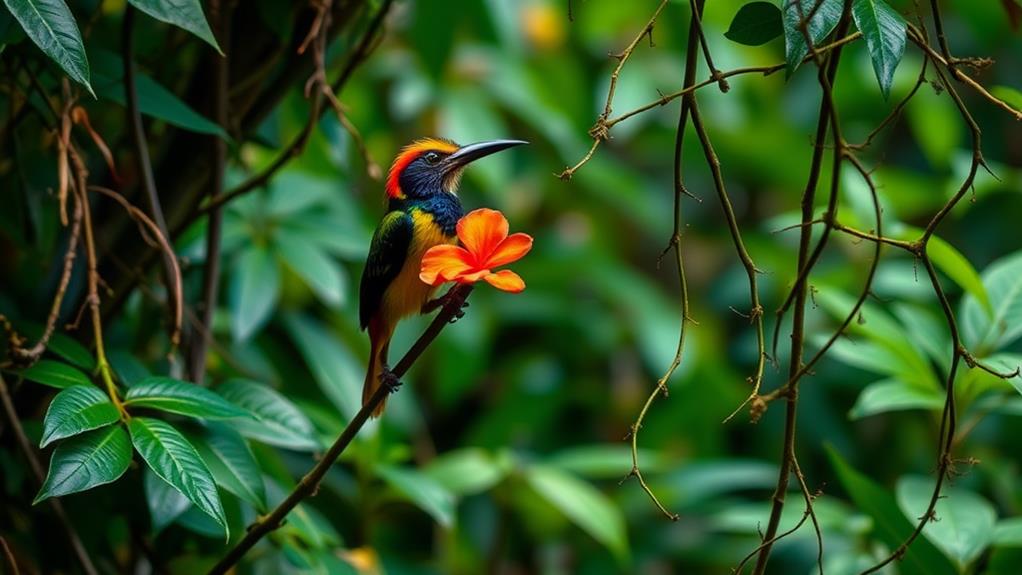
Conservation Efforts Yield Multiple Benefits
Protecting the Cebu Flowerpecker and its habitat has far-reaching benefits for ecosystems and local communities.
Conservation contributes to a healthier environment and a more sustainable future.
Enhanced Biodiversity
Conservation of the Cebu Flowerpecker's habitat maintains a diverse range of native species, crucial for ecosystem stability and resilience.
This diversity helps to regulate population sizes, maintain ecosystem processes, and adapt to environmental changes.
Habitat Rehabilitation
Reforestation and habitat rehabilitation initiatives increase food availability for the Cebu Flowerpecker, ensuring its breeding success and survival.
These efforts also improve water quality, reduce soil erosion, and support local agriculture.
Ecological Corridors
Establishing ecological corridors connects fragmented habitats, allowing for safe movement and genetic exchange among populations.
This connectivity is vital for the long-term viability of the Cebu Flowerpecker and other species.
Conservation Awareness
Engaging local communities in conservation efforts fosters a sense of responsibility and collaboration, promoting sustainable practices that benefit both the Cebu Flowerpecker and local ecosystems.
This awareness also educates communities about the importance of conservation and the impact of human activities on the environment.
How to Help
The Cebu Flowerpecker Needs Your Help
With only 60-70 individuals remaining, the Cebu Flowerpecker is critically endangered, and immediate action is necessary for its survival.
Your involvement can make a significant difference.
Reforestation Efforts
The Cebu Flowerpecker's habitat is dwindling due to deforestation.
Participate in local reforestation projects to restore its habitat and provide a safe environment for the species to thrive.
Preventing Illegal Logging
Illegal logging is a significant threat to the Cebu Flowerpecker's habitat.
Advocate for stricter enforcement of regulations against illegal logging in Cebu's forests to preserve the remaining habitats.
Community-Based Conservation
Educating locals about the importance of protecting the Cebu Flowerpecker is crucial for its survival.
Support initiatives that engage with local communities to raise awareness about the species' critical status and promote conservation efforts.
Conservation Organizations
The Cebu Biodiversity Conservation Foundation is working tirelessly to rehabilitate habitats.
Volunteer with the foundation to contribute your time or resources to habitat rehabilitation efforts, making a tangible difference in the species' survival.
Relevant Resources
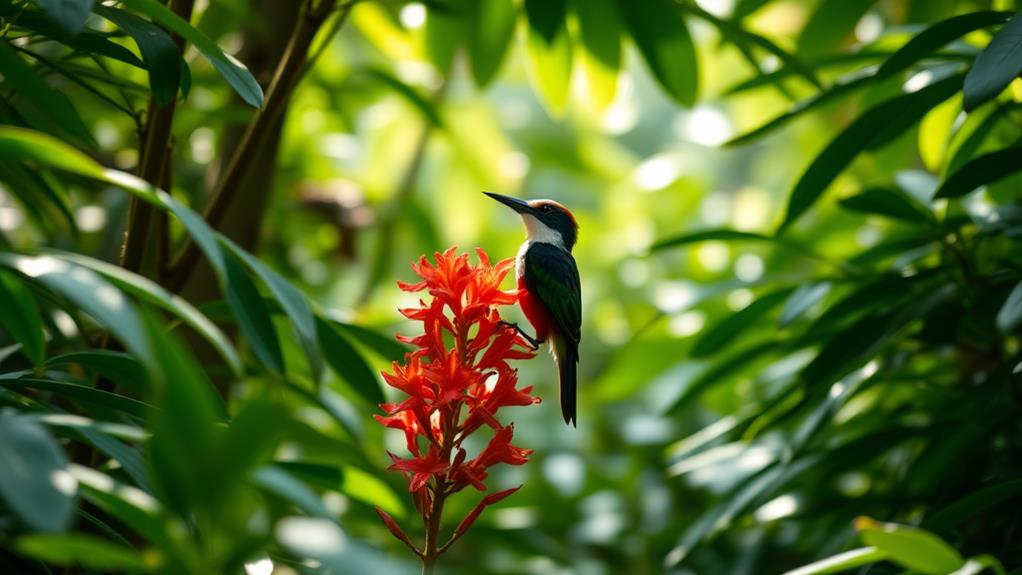
Accurate Information is Crucial for Conservation Efforts
To effectively support conservation efforts for the critically endangered Cebu Flowerpecker, it's essential to access credible and detailed resources.
With an estimated population of only 85-105 individuals, this species faces severe threats due to habitat loss.
Reliable Resources for Conservation
Four essential resources provide critical insights and updates on conservation efforts:
BirdLife International Red Data Book outlines the conservation status of the Cebu Flowerpecker and provides information on its habitat requirements.
Cebu Biodiversity Conservation Foundation leads habitat rehabilitation initiatives, offering updates on ongoing conservation projects aimed at protecting the remaining forest cover on Cebu.
Research Publications provide studies focused on the species' ecology and population monitoring, essential for formulating evidence-based conservation strategies.
Local Conservation Workshops connect individuals with like-minded people committed to protecting the Cebu Flowerpecker, providing updates on the latest developments in conservation efforts.
Questions and Answers
Where Do Cebu Flowerpeckers Live?
Cebu flowerpeckers inhabit tropical forest ecosystems on Cebu Island. These ecosystems are vital for maintaining avian biodiversity, and their conservation is crucial for protecting endemic species like the Cebu flowerpecker.
The Cebu flowerpecker's habitat is limited, which makes conservation efforts essential to ensure the survival of this unique bird.
Habitat loss is a severe threat to the Cebu flowerpecker. The destruction of its habitat is a significant concern, emphasizing the need for Cebu wildlife conservation efforts.
How to Protect a Cebu Flowerpecker?
Habitat Preservation is Key
To protect the Cebu Flowerpecker, preserving its natural habitat is crucial. This can be achieved through ecological restoration efforts, which involve replanting native trees and removing invasive species.
Additionally, sustainable tourism initiatives can help reduce human impact on the environment, promoting responsible travel practices that don't harm the bird's habitat.
Community Awareness and Engagement
Raising community awareness is essential to engage locals in conservation activities. This can be done through educational programs, workshops, and outreach activities that highlight the importance of protecting the Cebu Flowerpecker and its habitat.
Legislative Support
Strong legislative support is necessary to enforce protection against illegal logging and land clearing. Governments and policymakers must establish and implement laws that safeguard the bird's habitat and prevent human activities that threaten its survival.
Breeding Programs and Research
Breeding programs and research initiatives are vital to monitor the species' health and adapt strategies accordingly. These programs can help increase the population of the Cebu Flowerpecker and provide valuable insights into its behavior, habitat, and population dynamics.
What Is the Rare Bird in Cebu?
The Cebu Flowerpecker is the rarest bird in Cebu, an endemic species that plays a vital role in maintaining the island's biodiversity.
Its existence is crucial for the ecosystem's balance, as it helps to pollinate and disperse seeds, promoting the growth of native plants.
The destruction of its habitat poses a significant threat to its survival, highlighting the need for conservation efforts.
These initiatives not only protect the Cebu Flowerpecker but also promote avian research and sustainable wildlife tourism.
By supporting conservation initiatives, individuals can contribute to the protection of the bird and its ecosystem.
What Are the Endangered Plants in Cebu?
Cebu's Endangered Plants Face Critical Threats
Several plant species in Cebu are endangered, primarily due to habitat loss. The Cebu Mistletoe, for instance, is one such species that faces extinction.
These plants play a vital role in supporting native flora and contributing to biodiversity.
Conservation Efforts in Place
To address this issue, reforestation projects have been initiated to restore habitats and protect endangered species.
These efforts aim to preserve the island's unique plant life and maintain ecological balance.
Urgent Need for Action
The degradation of habitats in Cebu has a significant impact on the island's biodiversity.
Supporting conservation initiatives is crucial to preserve the island's rich biodiversity for future generations.